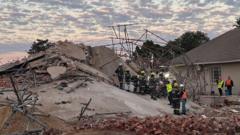The report indicated that serious concerns about the project's integrity, including the use of inferior materials and visible structural defects, were evident at least a year before the fatal incident. Macpherson, expressing outrage, pointed out the multiple "red flags" that were brought to attention, yet were disregarded. He condemned those responsible for allowing work to continue amidst glaring safety issues and emphasized that the health and safety officer’s resignation in protest signaled dire warnings that went unheeded.
Workers on the site reported unsettling vibrations within the structure, and alarming directives to mask structural holes with sand and substandard concrete. In a poignant statement following a private meeting with survivors and families of the victims, Macpherson called for accountability, urging criminal investigations against negligent parties involved. Despite ongoing police inquiries, no arrests have been made to date.
Many survivors are still grappling with lingering trauma, medical expenses, and financial difficulties. One survivor, Elelwani, shared her heartbreaking struggle in the aftermath of the incident, expressing her dire need for assistance due to harassment and physical health issues stemming from the disaster.
In response to this tragedy and to prevent future occurrences, Macpherson has committed to introducing stricter regulations on construction oversight and reforming outdated laws. The extensive investigation into the collapse was conducted by the Council for the Built Environment alongside a separate probe from the Engineering Council of South Africa.
Workers on the site reported unsettling vibrations within the structure, and alarming directives to mask structural holes with sand and substandard concrete. In a poignant statement following a private meeting with survivors and families of the victims, Macpherson called for accountability, urging criminal investigations against negligent parties involved. Despite ongoing police inquiries, no arrests have been made to date.
Many survivors are still grappling with lingering trauma, medical expenses, and financial difficulties. One survivor, Elelwani, shared her heartbreaking struggle in the aftermath of the incident, expressing her dire need for assistance due to harassment and physical health issues stemming from the disaster.
In response to this tragedy and to prevent future occurrences, Macpherson has committed to introducing stricter regulations on construction oversight and reforming outdated laws. The extensive investigation into the collapse was conducted by the Council for the Built Environment alongside a separate probe from the Engineering Council of South Africa.




















